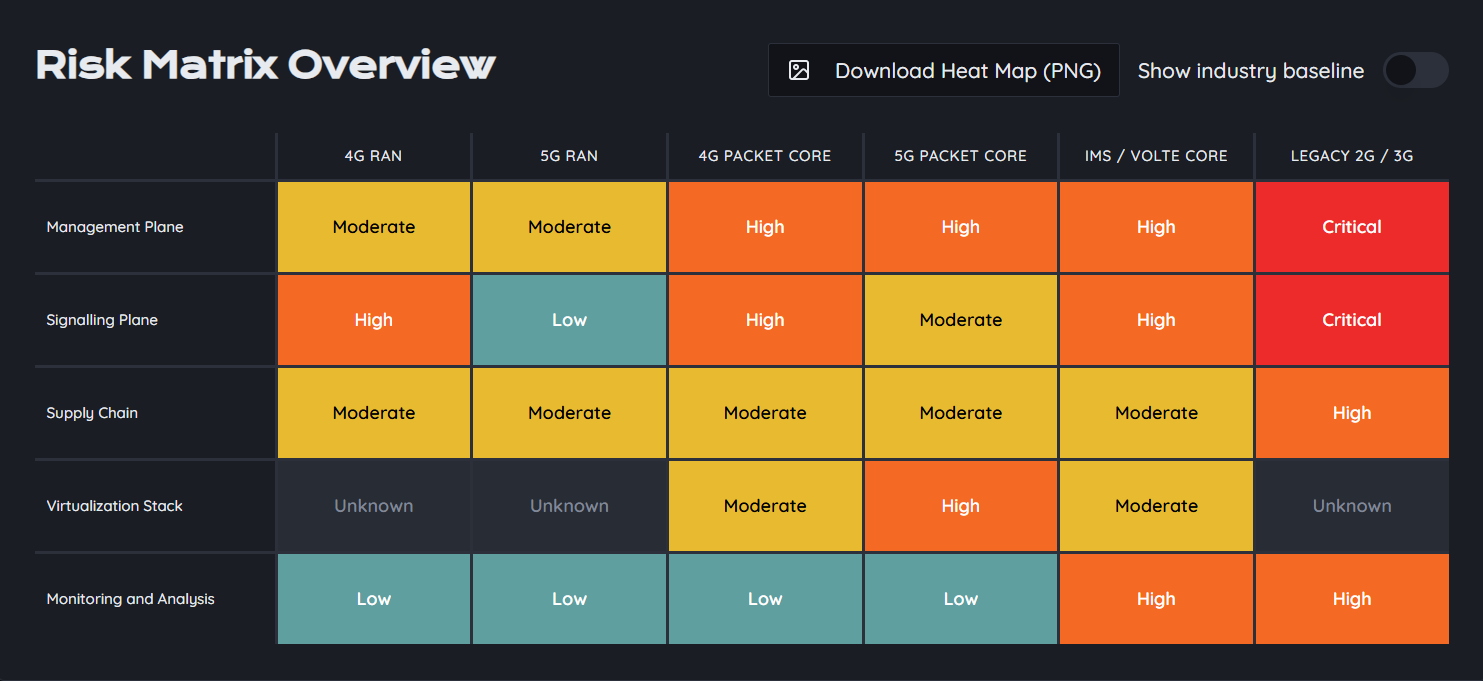What is SDN?
Software-Defined Networking (SDN) is an architectural approach that separates the control plane (responsible for deciding how traffic is routed) from the data plane (responsible for forwarding traffic). This decoupling allows network behavior to be dynamically programmed through centralized software-based controllers, instead of being manually configured on individual network devices.
In telecom networks—particularly 4G and 5G—SDN plays a crucial role in enabling agility, automation, and granular traffic control. It supports key functions like network slicing, edge routing, and traffic steering in cloud-native and virtualized environments. However, the same capabilities that make SDN powerful also introduce new attack surfaces and centralized points of failure.
Key Components of SDN in Telecom
An SDN architecture typically includes several core elements. The SDN controller acts as the central brain of the network, managing policies, flow rules, and topology. It communicates with SDN-enabled devices—such as routers and switches—using southbound interfaces, most commonly the OpenFlow protocol. Meanwhile, external applications and orchestration tools interact with the controller via northbound APIs, which expose programmability to higher-level management functions. The SDN-enabled devices themselves form the data plane and execute forwarding decisions based on instructions from the controller.
This separation of logic and hardware enables consistent network behavior, faster provisioning, and the ability to automate network responses to real-time conditions. It also integrates tightly with NFV environments, where virtualized functions need responsive, programmable connectivity.
Why SDN Matters in Mobile Networks
SDN is foundational to many of the core innovations in mobile telecom. It enables real-time automation of traffic routing and policy enforcement, making it essential for supporting 5G features like network slicing. It allows operators to dynamically create and manage isolated virtual networks for different use cases—such as IoT, mobile broadband, and emergency services—all over shared infrastructure. SDN also powers flexible service chaining and granular edge computing, allowing traffic to be routed efficiently between distributed nodes with low latency.
In addition, SDN enhances overall network visibility and control, providing operators with a central point of management for the entire infrastructure. These advantages are key to building scalable, adaptive, and service-rich mobile networks.
SDN Security Risks in Mobile Networks
While SDN introduces major operational benefits, it also changes the security landscape significantly. The centralization of the control plane makes the SDN controller a high-value target. If an attacker gains access to or disables the controller, the entire network can be disrupted. This contrasts with traditional telecom architectures, where distributed control logic provided some resilience.
APIs exposed by the SDN controller—especially northbound interfaces—can also be a security liability if not properly secured. Attackers may attempt to exploit these interfaces to manipulate network policies, inject malicious flow rules, or exfiltrate network metadata. Similarly, the protocols used in southbound communication, such as OpenFlow, may be susceptible to man-in-the-middle attacks or session hijacking if encryption and authentication are not enforced.
Another risk involves flow rule exhaustion. Because SDN-enabled switches often have limited flow table capacity, attackers can overwhelm them with crafted traffic patterns that generate excessive rule entries, leading to denial-of-service conditions. Multitenant environments, common in NFV-based 5G deployments, further complicate SDN security. Misconfigured policies or inadequate isolation can allow lateral movement or data leakage between tenants or slices.
Telecom-Specific Attack Scenarios
In mobile networks, SDN introduces unique security challenges tied to telecom use cases. For example, an attacker who compromises the SDN controller could hijack a 5G slice, redirecting its traffic or impersonating its endpoints. This kind of attack undermines the core principle of slice isolation. In another scenario, attackers might inject malicious routes that send signaling traffic to external destinations, facilitating surveillance or manipulation.
East-west traffic within the infrastructure—between virtualized network functions—can also be intercepted or mirrored using crafted SDN flows. This enables eavesdropping or traffic analysis if not properly monitored. Lastly, privilege escalation within the SDN controller environment could allow an attacker to pivot between the control plane and data plane, affecting both core and edge services simultaneously.
Best Practices for Securing SDN in Telecom Environments
Securing SDN in a telecom context requires a multilayered strategy. First, the SDN controller must be hardened and isolated. It should operate in a protected management domain, separate from tenant and user traffic. Access to the controller should be tightly controlled using role-based access control, multi-factor authentication, and network segmentation. Logging and monitoring of all control plane interactions are essential.
Northbound APIs should be exposed only to trusted systems, protected by strong authentication, encryption (such as mTLS), and rate limiting. It's also critical to validate all inputs and use API gateways to enforce usage policies. Southbound protocols like OpenFlow must be secured using encryption and mutual authentication between the controller and switches. Where possible, use hardened protocols or tunnels to protect command channels.
Flow rule creation should be governed by quotas and anomaly detection mechanisms to prevent exhaustion attacks. Operators should monitor for unusual flow patterns and periodically audit rules to ensure they align with security policies. Orchestration layers should include safeguards to verify that service definitions and manifests cannot introduce security regressions.
Redundancy is another key element. Controllers should be deployed in high-availability clusters with failover capabilities. In the event of a disruption, SDN devices should default to fail-safe behaviors that preserve baseline connectivity rather than fail-open to arbitrary traffic flows.
Compliance and Standards for SDN Security
Several standards and frameworks address SDN security in telecom contexts. The ETSI NFV and ZSM working groups provide guidance on automation, orchestration, and security alignment. The GSMA FS.36 specification outlines NFVI and SDN security requirements for multi-vendor telecom networks. Meanwhile, the Open Networking Foundation (ONF) publishes technical best practices for SDN component hardening and secure deployment. The 3GPP TS 33.501 document integrates SDN into the 5G security architecture, especially with respect to slicing, orchestration, and multitenancy.
These frameworks help ensure interoperability and secure design, especially in networks that span multiple vendors and layers of abstraction.
SDN vs Traditional Network Security: A Shift in Philosophy
In traditional telecom networks, the control plane is distributed and relatively static, making it more resistant to systemic compromise but less adaptable. SDN, on the other hand, centralizes control and prioritizes flexibility. This brings both opportunities and risks. Configuration management shifts from manual, device-level CLI commands to centralized, automated API calls. Visibility improves in SDN-based networks, allowing for global oversight and policy enforcement, but this visibility also depends on correct implementation and secure integration.
The attack surface becomes more concentrated in SDN environments, with the controller, APIs, and flow rules becoming the primary targets. Flexibility increases dramatically, enabling on-demand reconfiguration of the network, but so does the potential for mistakes or malicious interventions to affect large portions of the infrastructure instantly. The security paradigm must adapt accordingly, emphasizing control plane protection, continuous validation, and policy-aware automation.
Conclusion
SDN is transforming mobile networks from rigid, hardware-bound systems into agile, programmable environments. It enables essential features in 4G and 5G such as network slicing, dynamic routing, and edge service orchestration. But it also reshapes the threat landscape.
To secure SDN in telecom, operators must go beyond traditional perimeter defenses. They need to secure the controller as a crown jewel asset, harden communication interfaces, monitor flow behavior in real time, and align with telecom-specific compliance frameworks. As SDN continues to evolve, particularly in cloud-native and multi-domain architectures, understanding and mitigating its unique risks is essential to building resilient, secure, and future-ready mobile networks.
🔐 Looking for the full picture? Explore the Ultimate Guide to Mobile Network Security — your complete resource on telecom security, from architecture to audits.




